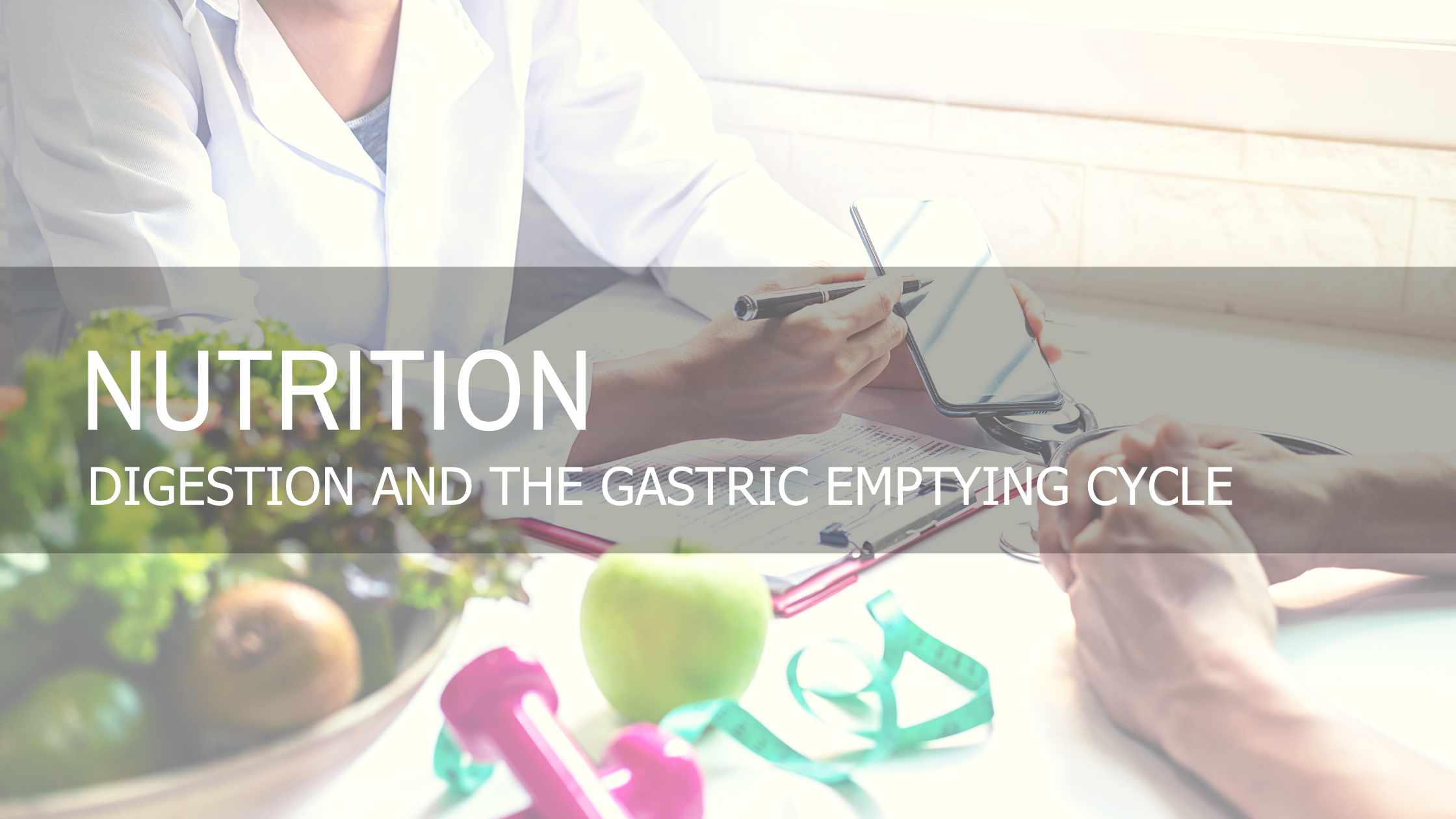
Apr 30 , 2021
0 Comments
Gut Health | Digestion and the Gastric Emptying Cycle
Digestion and the Gastric Emptying Cycle
Understanding your digestive, absorptive and metabolic systems, makes intuitive eating and dietary balance much easier to work towards.
Digestion:
The digestive system is made up of the gastrointestinal tract (i.e., mouth through colon), liver, pancreas and gallbladder. The hollow organs (mouth through anus) are where mechanical and chemical digestion take place. The solid organs include the liver, pancreas and gallbladder and these play a major role in the chemical part of digestion, by secreting and storing a variety of hormones and digestive juices. Parts of the nervous and circulatory systems also play important roles in the digestive system, providing innervation and blood to the organs involved. A summary of the digestive system and most of its parts can be found in the table below:
|
Organ |
Movement |
Digestive Juices Used |
Food Particles Broken Down |
|
Mouth |
Chewing |
Saliva |
Starches |
|
Stomach |
Upper muscle relaxes to let food enter & lower muscle mixes food with digestive juice |
Stomach acid |
Protein |
|
Small Intestine |
Peristalsis |
Small intestine digestive juice |
Starches, protein and longer chain carbs |
|
Pancreas |
None |
Pancreatic juice |
Protein |
|
Liver |
None |
Bile acids |
Fats |
Gastric Emptying:
The gastric emptying of nutrients happens at different rates, depending on the type of macronutrients. Carbohydrates are the quickest of the macronutrients to be digested and absorbed; where digestion begins in the mouth with chewing and salivary amylase. The rate of digestion will depend on the glycemic load of the carbohydrates. The digestive system can start extracting energy from low glycemic carbohydrates within 15 to 30 minutes, but high glycemic carbohydrate will take longer. Protein is the second of the macronutrients to be digested and absorbed. Digestion begins in the stomach with the acids secreted and movement and then continues in the small intestine with more digestive juices and peristalsis. Proteins, depending on their form, can take anywhere from 2-3 hours to leave the stomach. Fats take the longest to move through the digestive system. Digestion doesn’t begin until the small intestine with the digestive juices and peristalsis, as well as the pancreatic juices and bile acids that are secreted. Fats can take anywhere between 24 to 72 hours to be fully digested and absorbed.
Hormone Balance:
There are a variety of hormones that are involved in digestion, absorption and usage of food being consumed. Insulin and glucagon are two hormones that are produced by the pancreas and are essential in proper maintenance of blood sugar. When glucose enters the blood stream after a meal, the increase in blood glucose signals the pancreas to produce insulin. Insulin works on cells, signaling them to take up glucose from the bloodstream, lowering the blood sugar levels. Some cells convert glucose to usable energy, while others store it in the form of glycogen. Insulin also indirectly stimulates the accumulation of triglycerides (fat) in adipose tissue. Glucagon works as a counterbalance to the actions of insulin. Approximately 4 to 6 hours after a meal, blood glucose will decrease, which triggers the production of glucagon by the pancreas. Glucagon signals cells in the liver and muscles to change stored glycogen back into glucose, which then gets released back into the bloodstream.
Why is it important:
Understanding how the digestive system works with all its moving parts, means that more informed and intuitive eating can happen. A balanced diet includes, as well as other things, proper ratios of the three macronutrients. The percentages of macronutrients of an active individual should be approximately 45-55% carbohydrates, 15-30% protein and 20-30% fat. However, it is important to note that every person is a bio-individual and the ideal ratio of macronutrients will vary slightly. A balanced diet also includes a proper eating pattern. During the postabsorptive state (period after food has been digested, absorbed and used), when blood glucose decreases, glucagon is released by the pancreas, which then signals cells to release stored glucose. Once stored glucose is used up, the body has other ways of managing blood sugar levels, such as gluconeogenesis (production of glucose from non-carbohydrate sources; lactate, pyruvate, glycerol and certain amino acids). This process is much less efficient and requires energy. However, if the body must endure extremely long periods of time without food or too much of an energy/calorie deficit, the body will adapt by slowing down the metabolism. This means that the body will burn less calories and conserve nutrient stores to compensate for inadequate energy intake.
Goals
- Awareness:
- Do you know what you are eating and when?
- The first step to becoming a more intuitive eater is to make observations and become aware of your current patterns of eating.
- Complete a food journal for at least 4 or more days, preferably for 1 week. Note everything that you eat and drink during the day, as well as the timing of the consumption.
- Look back at the week for any patterns or red flags in what you are consuming and/or your food timing.
- Make Changes:
- .Take steps towards finding more balance in your food/beverage choices, as well as your pattern of consumption.
- Look at your food journal and note:
- Are you eating too much or too little of any macronutrient?
- Are you eating too much processed food?
- Are you eating at regular intervals throughout the day? Or are there long gaps of time in between meals? Or are you missing meals?
- Pick out at least one thing in your diet that could be improved upon and work on that.
- Consult:
- .If you are still unsure about where there might be gaps or imbalances in your diet, consider consulting a Registered Dietitian.
- Nutrition counseling with a dietitian can help you figure out more specifics about what macronutrient balance might work best for your lifestyle, as well as how to find food and timing balance, look for patterns and identify any areas that could use improvement.



